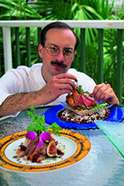

September/October
2001 Issue
 Savoring
the Seasons
Savoring
the Seasons
Harvests
no longer guide menus—taste buds do
There was
a time when the seasons had everything to do with what a chef put on the
table. When certain foods were out of season and unavailable, it was imperative
for a chef to be in tune with what was in season.
Today, it’s different. “Seasonal”
is more of a state of mind—what feels right and tastes good. Most
foods, even if they aren’t local, are usually available. Still, nationwide,
the tradition of seasonal menus has not disappeared over the years, and
Southwest Florida is no different.
Despite the fact that the area doesn’t have
much of a change in seasons, local chefs take sometimes painstaking efforts
to make sure their customers get the best taste of the seasons, whether
it’s from a local vendor or a well-known, nonlocal one.
Robert Frederick, executive chef for Sanibel
Harbour Resort & Spa (17260 Harbour Pointe Drive, Ft. Myers,
941/466-2156) is a serious season man. Twice per year he takes time
out from his busy schedule to tinker with at least one of his menus from
Chez le Bear, Promenade Café, or the banquet menu. For Chez le
Bear, the resort’s signature restaurant, which serves Mediterranean
fare, he is particularly fastidious, offering a summer/fall menu and a
winter/spring menu. “I’d even like to do four,” he adds.
Although the resort’s banquet menu stays
mostly the same, he feels that it is still important to revamp every other
year. And as for the Promenade, he tweaks that menu periodically.
Frederick orders a vast amount of specialty goods
from two places in Massachusetts—Browne Trading and Sid Wainer—and
discusses with them what foods are fresh and look the best during different
seasons. For example, he says, razor clams are sometimes hard to get and
baby artichokes have their own special seasons. “But I also use a
lot of locals,” he adds, for mangoes, papayas, and other locally
grown produce.
When creating a dish, he works backward, considering
first the presentation on the plate. “I want to end up with what
looks good.” He thinks about the colors and textures that he wants,
then about what sort of seasonal dish would fit.
For executive chef Shannon Chandler at Roy’s
of Bonita Springs (26831 South Bay Drive, 941/498-7697), seasonal
cooking means lighter in the summer and heavier in the winter.
“The sun’s out until 9 o’clock
during the summer, so I like to do things that are refreshing but fulfilling,”
he says, such as using more vinaigrettes. Winter calls for thicker sauces
and richer items, he adds; even though it’s warmer here than most
other places, patrons still expect seasonal- type meals.
Roy’s is a Eurasian fusion-type restaurant
that uses Hawaiian or Asian preparations, but Chandler stresses that a
third to one-half of Roy’s daily specials are fish, meats, or vegetables
that are in season here.
“We use local ingredients in our style,”
he says, such as the local heirloom tomatoes (a variety that hasn’t
changed its strain in 100 years). “They’re some of the best
tasting and textured.”
Sous-chef Jamie Romans of Chadwick’s Restaurant
(at the entrance to South Seas Resort on Captiva Island, 941/472-7575)
views seasonal menus as an important part of what he does. “We change
the menu depending on who’s here and what’s in season.”
Chadwick’s prides itself on its Florib-bean
feast and island rhythms. In the summertime, Romans serves clear and fruit
soups with fennel, fresh tomatoes, and cucumbers—of course all are
local, he says. During the colder months, he frequently uses such winter
squashes as butternut and pumpkin, even in his desserts. “I do some
things with ice cream that you’ve probably never seen.”
Although a big believer in using local fare, Carlo
DiSomma, co-owner/chef of Greenhouse Grill (2407 Periwinkle
Way, Sanibel, 941/472-6882) doesn’t really believe in traditional
“seasonal” menus. Coming from a family of hoteliers, he remembers
when restaurants had to grow their own vegetables and couldn’t get
certain items at particular times of the year, “like mushrooms,”
he says. “They used to only be in fall.”
Now, anything and everything can be had at any
time. But DiSomma doesn’t want to get everything all the time. The
way he sees it, restaurants should take advantage of what is fresh locally.
“Greenhouse Grill plays specifically with
Florida fish—like grouper and trigger. We give it a local taste,”
he says.
DiSomma buys his produce locally, because “the
taste is different. Florida has beautiful products. We should use them,”
he says.
“Why we do Mediterranean flavor here is because
Florida and the Mediterranean are so similar.”
His philosophy is simple. “We have to support
and promote everything around us,” he explains. That doesn’t
mean he doesn’t change his menu. On the contrary, DiSomma says he
and his partner (who bought the restaurant last December) plan to revamp
the menu for the fall. He plans to provide other interesting items with
different cooking techniques. Greenhouse Grill will add a wood-burning
oven and also make its own focaccia bread.
At Beachview Steakhouse and Seafood Restaurant
(1100 Par View Drive, Sanibel, 941/472-4394), which serves dinner
seven months of the year and lunch year-round, the daily menu stays basically
the same. But, says manager Kevin Rice, “Every year we do change
it, depending on what works and what doesn’t.” Rice says his
most recent change will be a bone-in filet.
Planning any menu, seasonal or not, is never an
easy task. So, what’s the real secret to the success for local menus?
Making sure the customers like it and “trying
to provide it to them before they even ask,” says Romans of Chadwick’s.
“I like to beat them to the punch.”
Although a mediocre cook at best, Jennifer Grant, a freelance writer
from Bonita Springs, admits that one of her favorite pastimes is enjoying
great food.